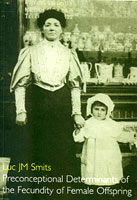|
|
Reduced fecundity because of maternal high-risk conceptions (OVF)

|
Dissertation Smits
|
The Research on Reduced Fecundity (OVF) was a joint project with the Department of Medical Information Science at the University of Nijmegen (KUN). The project started September 1, 1993, and was financed by NWO-Medical Sciences (NWO registration number: 900-561-064).
The research is testing indications that persons conceived in situations of hormonal imbalance run a higher risk of pathology. With women this may result in a reduced fecundity.
A hormonal imbalance is presumed to occur in the first years after the menarche, in the final years before menopause, in the first period after a pregnancy and after a long period of infertility. It may also occur in certain seasons.
The hypothesis that female fecundity decreases when a woman is conceived in a situation of hormonal imbalance can be epidemiologically approached using historical demographic data. This is where the HSN data files play an important role. A sample of the female population in Rotterdam born between 1873 and 1902 has been constructed. This sample consists of four control groups and four risk groups. By means of family reconstruction, it can be checked whether risk groups show reduced fecundity. Besides the number of born and their chance of survival, data used are numbers of still-born and twins, sex ratio, birth intervals and seasonal fluctuations in the numbers of birth.
The largest portion of the risk groups was constructed by means of a direct sample from family cards. The basic HSN data file and an over-sampling for the period 1873 to 1902 (n total = 2100) supplied the control groups. The gathering of the data was completed in November 1996. Ultimately this database contained 2591 sample persons with family reconstructions, 1500 persons coming from Rotterdam, the rest from all over the country. The research was finished in 1998, with the promotion of Luc Smits (L.J.M. Smits, Preconceptional determinants of the fecundity of female offspring (thesis Katholieke Universiteit Nijmegen, 1998). In 2002, the last planned article was published in the International Journal of Epidemiology.
The structure of the research and the database is described in K. Mandemakers, Definities en beschrijving database Onderzoek Verminderde Fecundabiliteit (October 1996).
Top
|
|

